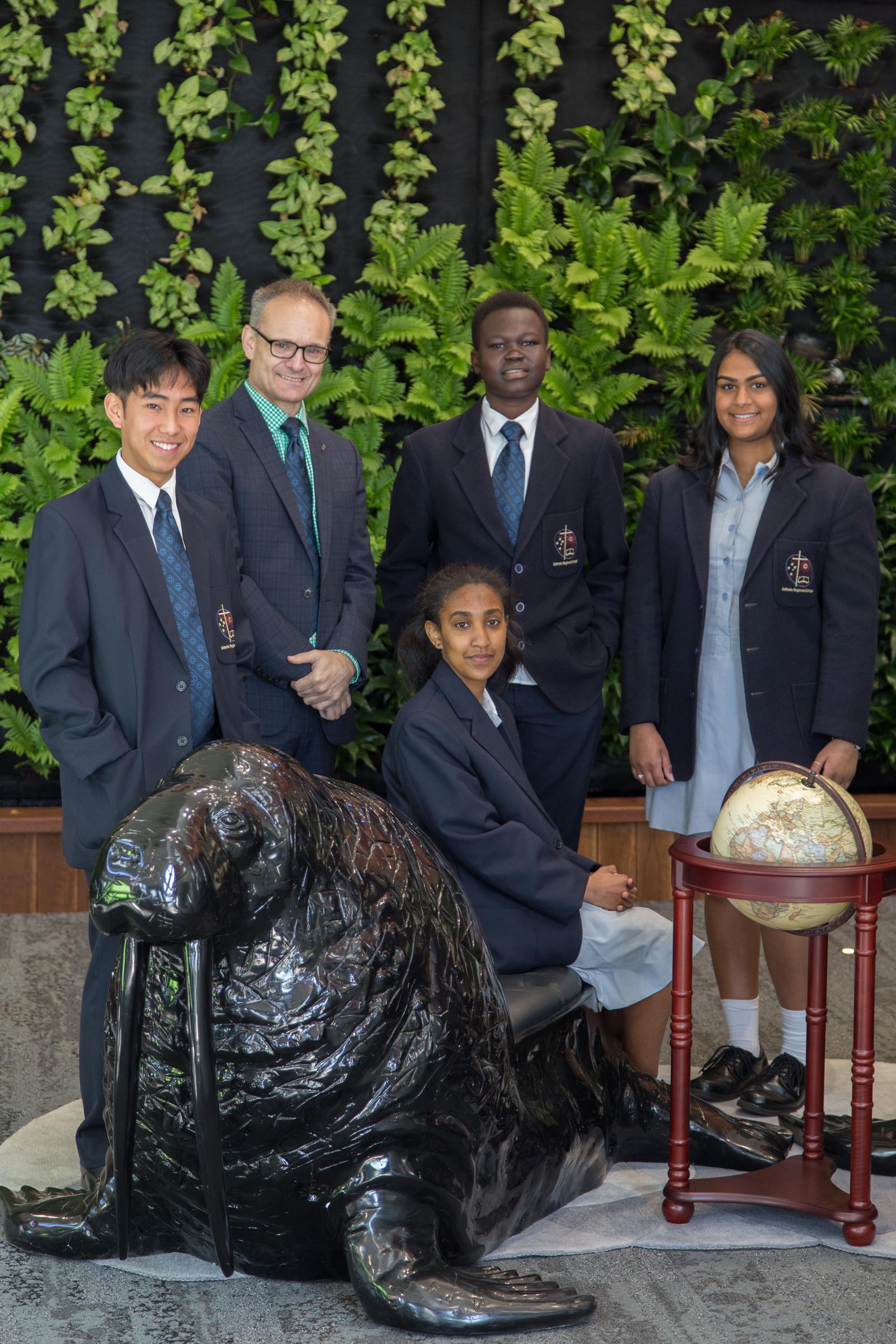Principal's Report

VCAL Partner Achievement Award – Workplace Learning
Trade Training Centre at Catholic Regional College
Congratulations to the team in the TTC who have been recognized for their work in education with the State Government VCAL Partner Achievement Award. The citation for the award reads as follows:
The Trade Training Centre at Catholic Regional College (CRC) located on the Sydenham site provides on-site training in hospitality, beauty services, retail baking, sign-writing and picture framing, giving VCAL students the opportunity to complete authentic training at school. The centre is also used by other schools in the region. The centre’s facilities include Quatrefoils Restaurant, SYD Signs, Frames@CRC, The Crate Theatre and CRC Bakery and Patisserie, all of which are student-run businesses open to the public.
The centre’s training philosophy is to build skills for students in real-life settings. VCAL students undertaking a Certificate II in Signage and Graphics gain experience by working in the workshop and business shopfront of SYD Signs. Similarly, students doing a Certificate II in Furnishing (Picture Framing) get to hone their skills at Frames@CRC. Those completing their Hospitality certification can work at Quatrefoils, a fine dining restaurant that seats 100 and is open to the public three evenings a week.
With many students at CRC being newly arrived in Australia or from an EAL (English as an additional language) background as well as students who want to pursue a trade qualification, the school has adopted a true applied learning pedagogy. The school involved industry in all aspects of planning for the VCAL and VET programs and the Trade Training Centre to encourage partnerships with business and provide students with post-school pathways.
The only purpose of the enterprises within the Trade Training Centre is to serve the training and learning needs of the students within the VCAL and VET programs. The income from each business is reinvested into the centre, providing industry-standard equipment and fee-free VET courses on site for students.
The partnership between the Catholic Regional College Trade Training Centre and Sydenham’s VCAL program has been highly productive and has led to remarkably high levels of student engagement and achievement.
Congratulations to Rocco (Picture Framing), Peter (Baking), Keith (Signage), Richard, Marie, Beth and Renee (Hospitality), Grace and Rebecca (Beauty).
Art Award to Catholic Regional College Sydenham student
We were delighted to be informed that one of our students Uyen Nguyen (Year 12) was awarded The Julia Flynn Memorial Award which is the Secondary award for the student whose work best reflects the spirit of the Catholic Education Week Visual Arts Exhibition and a deeper meaning and value of life. A perpetual trophy was awarded as well as a certificate together with the recognition that comes with winning this prestigious art award. We congratulate Uyen and also recognise Cinzia, the Art and Studio Arts teacher at the College.
Have you noticed…
Families may have noticed a ‘tiny house’ or mobile house on wheels in the driveway at the College. There are actually two of these vehicles and they are to be our new Barber Shop and Beauty Salon. These two businesses will commence in Term 2 with the Beauty Salon specialising in the Debutante Ball and School Social market. This year we have employed a Barber to deliver the Barbering training package due to students wishing to undertake this VET qualification. The result is a new mobile barber shop open to the public where patrons can get a haircut from a barber in training under the supervision of a fully qualified Barber. We are grateful to our community for their patronage of all of the businesses we operate to support student learning and encourage all families to come and try out at least one of the two new enterprises located in the Tiny Houses.
‘the darkest days of our proud history….’
The Archbishop of Melbourne spoke at the Catholic Education Dinner on the Friday evening prior to St Patrick’s Day. His speech came at the end of a week which saw Cardinal Pell receive a custodial sentence following his conviction for child sexual abuse. The text of the Archbishop’s speech are included. Our Archbishop has understood how many of us are feeling, knowing it has been difficult to be a Catholic in light of the press reports surrounding the high profile court proceedings. The Archbishop describes this time of deep crisis and humiliation, recognising that the landscape for the Church has changed. His Grace goes onto set all Catholics across the Archdiocese a challenge, reminding us it is Christ we follow and it is time to be Christlike. I commend to our community the message of our Archbishop, a man who will lead our Church and us through this time.
Brendan J Watson OAM
Principal
Delivered by Most Rev Peter A Comensoli
Ninth Archbishop of Melbourne
15 March 2019
You have to feel just a little bit sorry for Palladius of Poitiers, sent by Pope Celestine I as the first Bishop of Ireland. Usually being the first earns you some kudos, but not for poor Bishop Palladius. Having arrived in 431AD, he was unceremoniously banished in the same year to northern Britain by one of the clan kings. Whilst leaving behind the foundations for a few churches, some books, relics and two companions – he did not manage to leave behind a community that had the strength to flourish beyond its hidden existence.
The second Bishop of Ireland, on the other hand, sent the following year in 432, also by Pope Celestine, fared somewhat better. He headed north, successfully connecting with the small Christian groups already there, and then systematically went about converting the clan leaders of the old religion to Christ. By the time of his death, Ireland was acknowledged as a Christian country, and his name become synonymous with that land. His name of course was Patrick, second Bishop of Ireland, but Numero Uno in status.
St Patrick is something of a colossus for the Catholic Church in Melbourne. He stands at the pinnacle of a deep cultural heritage that has marked us out as the most Irish of cities in Australia. The Churches, schools and other buildings named after him – along with those who followed him – are like beacons that criss-cross the city in a kind of Irish saintly trail. Melbourne is deeply Patrician, and his saintly presence runs deep within our psyche.
But how well do we know him? We can tend to rely on the fables and stories about Patrick to paint a picture of him. The miraculous Patrick who founded Christian Ireland; the story-telling Patrick who used a shamrock to convert a people; the banisher of snakes Patrick; the converser with ancient ancestors Patrick. These ideas of Patrick have created an impression of him that has a certain hold over us, even today. But is this the real Patrick?
For example, Patrick is often portrayed as a local lad done good. But historians tell us that he was probably a Roman Britain, who first encountered Ireland as a slave in his teens. He converted to Christianity there, but soon escaped to Britain and onto Europe, taking up studies
in the faith and growing in missionary zeal. We owe a great deal to the anonymous Christians who inspired, formed, and educated him. So, Patrick was a foreigner when eventually he was sent to Ireland as a bishop, and he remained somewhat an outsider among many of the local Celtic clans, the bearer of a new religion and strange customs.
There is also a habit of portraying Patrick as the missionary founder of Christianity in Ireland, but we bishops only get sent to existing local Churches. There were already small Christian groups in Ireland before Patrick arrived, established by missionaries who had gone ahead of him. The seed of faith had already been planted. But, unlike the civilisations of Europe, Ireland under clan leadership lacked real communities or townships. What Patrick did most effectively was to embody (incarnate) the Christian faith into the existing culture and draw people together into like-minded, faith-minded communities.
One more impressionistic image of Patrick is worth keeping in mind. While he was certainly an extraordinary missionary, travelling the length and breadth of Ireland, he wa

